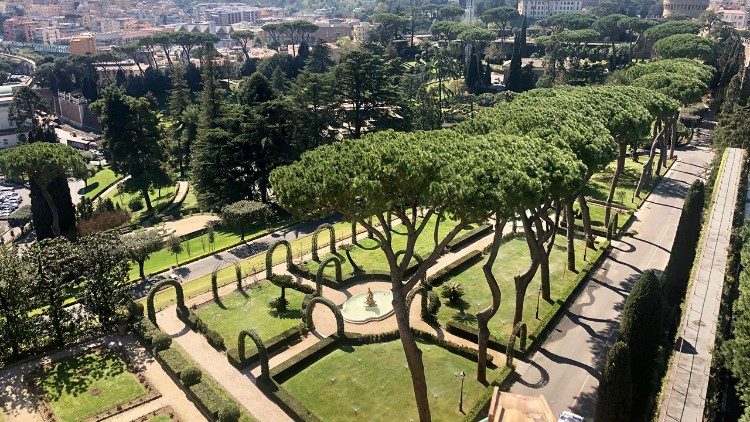
Vatican to go green by 2050
By Nicola Gori
The objective of “zero emissions” for Vatican City State by 2050 is not just a dream, but an achievable goal, according to the head of the Directorate for Infrastructures and Services, Father Rafael García de la Serrana Villalobos. In this interview with L’Osservatore Romano, Fr García de la Serrana Villalobos says the Governorate of Vatican City is undertaking projects and initiatives aimed at reducing environmental impact, waste, and energy consumption; and using more renewable resources.
Q. What are the main actions you will carry out in view of this objective?
A. Climate neutrality can be achieved by Vatican City State primarily through the use of natural sinks, such as soil and forests, and by offsetting emissions produced in one area by reducing them in another. Of course, this is done by investing in renewable energy, energy efficiency or other clean technologies such as electric mobility. And we are promoting green economy policies, i.e. circular economy policies, such as the transformation of organic waste and bio-waste into quality compost, and a waste management policy based on the concept of considering it not as waste but as a resource.
Q. Which sectors will be particularly affected?
A. Many sectors will be involved, starting with energy engineering, with the upgrading of technological systems, i.e. thermal power stations and air conditioning systems. As far as water is concerned, the use of water resources has been optimised, with closed circuits in the fountains, cooling of the refrigeration units and the first rain tanks for irrigation purposes. The rational use of electricity is also important, with LED lamps and imported [electricity] from renewable sources. But also the reduction of common waste, through the computerised digitalisation of documents, the use of electrically-powered service cars, and drinking water distributors. Not forgetting the reforestation programme in areas belonging to the State that compensate as much as possible for the emissions produced. Projects are being studied for the recovery of urban waste, enabling it to be transformed into a resource, both thermal and electrical, as well as the transformation of hospital waste into fuel, thus avoiding its management as hazardous waste. There will be a gradual replacement of the car fleet with electric or hybrid-powered vehicles, and regular maintenance of the vehicle fleet in order to reduce consumption. And in general, the impact on the environment [will be reduced] through approved and certified disposal, recovery and scrapping operations.
Q. Where do we stand now with emission reductions? Which facilities have already reached the target?
A. In recent years, the Directorate for Infrastructure and Services of the Governorate has undertaken a series of initiatives for regulatory compliance and energy upgrading of technological systems; starting with the ratification of the Montreal Protocol in 2008, with the gradual replacement — from 2012 to 2020 — of old refrigeration units that used non-ecological gases with new units that perform better in terms of energy efficiency. But also with other significant initiatives: the construction in 2008 of a photovoltaic system on the roof of the Paul VI Hall, the installation in 2009 of a solar-cooling system to serve the cafeteria of the industrial centre and, in 2010, a new district heating plant with high-efficiency generation units and optimisation of the heat production and exchange systems. From 2012 to 2020, the power plants and thermal substations and their temperature control systems were also upgraded, in order to achieve better performance in terms of energy efficiency, with a reduction in the consumption of methane gas and electricity and in polluting emissions into the atmosphere. Direct expansion air conditioning systems were retrofitted and replaced with systems with a lower environmental impact and less energy consumption. Ventilation systems with heat recovery were also installed. The goal of importing electricity produced entirely from renewable sources was already achieved in 2019. The sale of single-use plastic products has also been eliminated.
Q. What about, in particular, the protection and care of the natural environment?
A. A reforestation programme has been promoted in the State, which in three years has led to the planting of 300 trees of various species. An important milestone in terms of respect for the environment is that this year the State has achieved its goal of being pesticide-free. A new watering system for the Vatican Gardens has also been installed, saving about 60% of water resources. The separate collection of urban waste has been encouraged, rising from 42% in 2016 to 65% in 2020, with a target of 75% by 2023. Special waste has been separated by 99%, allowing 90% of waste to be sent for recovery, thus giving value to the policy of treating waste as a resource and no longer as waste. For example, paper and cardboard; used vegetable oils, which are reused to produce biodiesel; used lead batteries; and mineral oils are recovered and recycled. PET bottles are also recovered, through the distribution of dedicated compactors within the State, and waste materials from the maintenance of green spaces and organic waste are transformed into quality compost, used in the Vatican Gardens.
Thank you for reading our article. You can keep up-to-date by subscribing to our daily newsletter. Just click here






